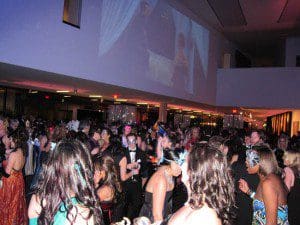Gerhard Richter’s enormous mural Strontium glowered over Wilsey Court. The mural, made from a collection of blurred photographs representing the atomic structure of strontium titanate (a substance used to make artificial diamonds), might have been interpreted as a bit of a symbolic downer on the festivities, which celebrated both the high and the low fruits of early-Renaissance wealth. Projected on an adjacent wall was the flashier and less demanding 1964 Vincent Price horror flick, Masque of the Red Death. Downstairs, the lauded exhibition, “Masters of Venice: Renaissance Painters of Passion and Power” was open to any partygoer who wanted to view it, and at any other time that might have been more tempting, especially considering these were its last days in San Francisco. After all, how often can one see Titians, Tintorettos, Giorgiones, and Veroneses in this hemisphere? But the people who came out for the masked ball at the De Young that night seemed reluctant to defer to any artwork other than that which they had made of themselves. People concocted different “fancy dress” iterations of the past 400 years, and wore or even painted on elaborate carnival masks, a combination that evoked the formal glamour of opening night at the opera with the DIY exuberance of Halloween. There were tables holding different kinds of brie and bars serving pink and orange drinks with edible flowers and blood orange slices. Caterers with trays of mini tiramisus dodged patrons whose peripheral vision was mask-obscured; there was a lot of “Pardon me,” “oops, so sorry,” and “oh dear, can I get you another one of those?” that night.
The crowd was young—most looked to be in their 20s and early 30s—and though DJ David Carvahlo seemed to have tailored his repertoire based on the assumption that his audience had a short-term memory for pop music, the floor was packed throughout most of the night. (I attribute this in part to some guys being more willing to dance, and being much better dancers, if their faces are concealed. Likewise, women last longer on the dance floor if their dates aren’t visibly perishing from awkwardness.) Patrons not only danced but sang along to Gaga, Beyonce, and RiRi, and didn’t even object when the music occasionally degenerated into dubstep. There were very few nods to music from further back than five minutes ago. But when older tunes did play, they were either unflatteringly remixed, as in the case with Prince’s When Doves Cry (rendered near-unrecognizable via a monotonous techno beat and superfluous synth), or expertly transmogrified into songs one would have thought them to be insurmountably incongruous with, in terms of melody, tone, and even rhythm. How did Don’t Stop Believin’ slowly turn into Billie Jean? And why did it seem so natural? Many of the more recent songs were simply compounded to mystifying effect. Having told most of the popular music of the past 150 years to get off my lawn, perhaps I am less informed than most, but I was unsure whether these were arrangements Carvahlo created himself. Or is there some factory in China that produces forced and unholy (but admittedly brilliant, doubly-danceable, and ideologically confounding) mashups like All the Single Ladies/Back That Ass Up?
Few partygoers were curmudgeonly enough to resist the pull of the dance floor, and as the night progressed so grew the collection of kicked-off platform stilettos at the foot of Strontium. In one of those occurrences that are not rare but nevertheless always surprising, there was a spontaneous moment of poignancy, as if leaked in from another world: Whitney Houston had died that afternoon; most of the maskers had probably heard the news while dressing for the ball. What better tribute to the lost diva than a floor full of revelers dancing (and singing) with the abandon of the unwatched to I Wanna Dance with Somebody?
Read more from Larissa Archer at her blog, larissaarcher.com.


One thought on “Bending Time and Music: Celebrating ‘Masters of Venice’ at the De Young Museum”